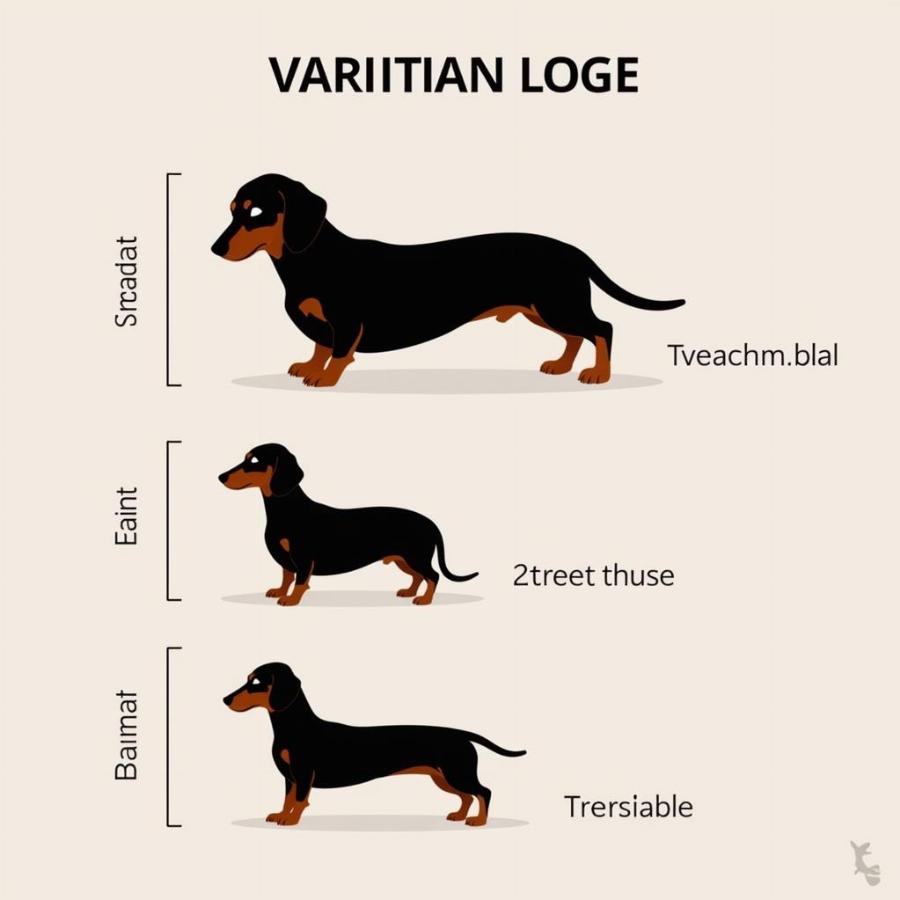Dachshunds, affectionately known as weenie dogs, sausage dogs, or badger dogs, are charming and distinctive with their long bodies and short legs. But just how long can a “longest weenie dog” get? This article dives into the fascinating world of dachshund length, exploring the breed standards, record holders, and the factors that influence their unique physique. We’ll also discuss the potential health implications associated with extreme lengths and how responsible breeding practices are crucial for the well-being of these lovable canines.
Unraveling the Dachshund Breed Standard and Length Variations
The American Kennel Club (AKC) doesn’t specify a maximum length for dachshunds, focusing instead on weight and chest circumference. Standard dachshunds typically weigh between 16 and 32 pounds, while miniature dachshunds should ideally weigh under 11 pounds. While length isn’t explicitly defined, it’s important to understand that exaggerated lengths can lead to health issues. The dachshund’s elongated spine makes them prone to intervertebral disc disease (IVDD), and excessive length can exacerbate this risk.
 Dachshund Length Variations
Dachshund Length Variations
The Quest for the Longest Weenie Dog: Myths and Reality
While stories of exceptionally long dachshunds abound, verified records are scarce. The Guinness World Records doesn’t currently have a category for “longest weenie dog.” This is likely due to the ethical concerns surrounding encouraging breeding for extreme size, which can compromise a dog’s health. However, anecdotal evidence suggests some dachshunds have reached impressive lengths, sometimes exceeding three feet from nose to tail.
Factors Affecting Dachshund Length: Genetics and More
Several factors contribute to a dachshund’s length. Genetics play a primary role, with some bloodlines naturally producing longer individuals. Nutrition also plays a part, as overfeeding during puppyhood can lead to excessive growth, potentially impacting length. However, it’s crucial to prioritize healthy growth and development over achieving extreme lengths.
Health Concerns Related to Extreme Length in Dachshunds
The dachshund’s unique physique, while endearing, comes with specific health challenges. Their long backs make them susceptible to IVDD, a painful condition affecting the spinal discs. Obese or excessively long dachshunds are at a higher risk of developing this condition. Responsible breeders strive to maintain healthy proportions and avoid breeding for extreme lengths, prioritizing the dog’s overall well-being.
Caring for a Long-Bodied Dachshund: Tips and Considerations
Whether your dachshund is exceptionally long or within the typical range, proper care is essential for their health and happiness. Supporting their long back is crucial. Avoid letting them jump from heights, and provide ramps or steps for accessing furniture. Maintaining a healthy weight through a balanced diet and regular exercise is also vital in preventing IVDD and other health issues.
Conclusion: Appreciating the Dachshund’s Unique Charm
While the quest for the “longest weenie dog” might be intriguing, it’s important to prioritize the health and well-being of these beloved companions. Responsible breeding practices and proper care are crucial for ensuring a long, happy, and healthy life for your dachshund, regardless of their length.
FAQs about Dachshund Length
- What is the average length of a dachshund? There isn’t a definitive average length, but most dachshunds measure between 12 and 16 inches tall at the shoulder and their body length is typically twice their height.
- Is there a Guinness World Record for the longest dachshund? No, there is currently no such record.
- Can a dachshund’s length affect its lifespan? Extreme length can increase the risk of health problems like IVDD, potentially impacting lifespan.
- How can I prevent back problems in my dachshund? Maintaining a healthy weight, avoiding high jumps, and providing proper back support are crucial.
- Are longer dachshunds more prone to health issues? Yes, excessive length can exacerbate the risk of IVDD and other back-related problems.
Beaut Dogs is your trusted source for all things dachshund, providing expert advice and information on breed characteristics, care, and health. For personalized guidance and answers to your specific questions, contact us at Email: [email protected]. We’re here to help you provide the best possible care for your beloved weenie dog. Visit Beaut Dogs (https://beautdogs.com) today!